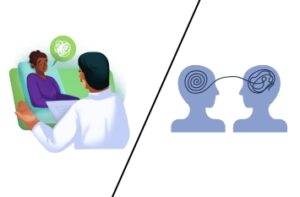
Counseling vs. Therapy: What’s the Difference, and Which One Do You Need?
Counseling vs. Therapy: What’s the Difference, and Which One Do You Need? When You’re Ready to Seek Support When you’re ready to seek support for

Do you ever feel an overwhelming sense of restlessness or, on the flip side, find yourself moving through life at a sluggish pace? You might be experiencing psychomotor agitation or retardation, terms that are often confused but represent distinct concepts in mental health.
While they may sound similar, psychomotor agitation involves excessive, uncontrollable movement and heightened activity, whereas psychomotor retardation is characterized by a noticeable slowdown in both movement and thought processes.
Understanding these differences is essential for clarity and proper management, as they highlight contrasting aspects of how our mental and physical states can manifest. Let’s explore what sets these two phenomena apart and why they matter.
Psychomotor agitation is a state of heightened emotional and physical activity that can make an individual feel unusually restless or frenetic. This condition involves an array of behaviors, from excessive pacing and fidgeting to rapid, pressured speech.
People experiencing psychomotor agitation often find it challenging to remain still, and their heightened activity can be a response to underlying emotional turmoil or stress.
This state is frequently observed in various mental health conditions and can significantly impact one’s ability to function in daily life.
Psychomotor retardation, in contrast, describes a noticeable slowing of physical and mental processes. Individuals with this condition may experience reduced movement, slow speech, and a general sense of lethargy that affects their ability to engage in routine activities.
This slowdown can manifest as difficulty initiating tasks or an apparent delay in cognitive responses. Psychomotor retardation is often a symptom of mood disorders and can profoundly affect an individual’s overall quality of life, making everyday tasks seem more laborious and time-consuming.
Psychomotor Agitation Examples:
Psychomotor Retardation Examples:
Psychomotor agitation and retardation, while seemingly opposites, both represent disruptions in normal motor and cognitive functioning, often linked to underlying mental health issues. Agitation is characterized by excessive movement and heightened activity, while retardation involves a slowing down of these processes.
Despite their contrasting manifestations, both conditions can occur within the same individual, especially in complex mental health disorders where symptoms fluctuate.
Aspect | Psychomotor Agitation | Psychomotor Retardation |
Description | Excessive and uncontrollable physical activity | Noticeable slowdown in movement and thought |
Emotional State | Often linked to heightened stress or anxiety | Frequently associated with feelings of lethargy |
Movement | Rapid, fidgety, and restless | Slow and deliberate; reduced physical activity |
Speech | Rapid, pressured, and excessive | Slow, deliberate, and sparse |
Behavioral Impact | Difficult to sit still or remain focused | Challenges in initiating and completing tasks |
Potential Overlap | Can occur with retardation in mood disorders | Can appear with agitation in severe conditions |
Managing psychomotor agitation and retardation involves a combination of strategies aimed at alleviating symptoms and improving overall well-being. For those experiencing agitation, the focus is often on techniques that help reduce excessive energy and promote relaxation.
Conversely, managing retardation typically involves strategies to enhance motivation and counteract sluggishness. Implementing a holistic approach, which may include therapy, medication, and lifestyle adjustments, can be highly effective in addressing these conditions and improving daily functioning.
For Psychomotor Agitation:
For Psychomotor Retardation:
Preventing psychomotor agitation and retardation involves managing stress, maintaining mental health, and leading a balanced lifestyle. While some risk factors are beyond control, adopting healthy habits can reduce the likelihood of developing these conditions.
Prognosis varies based on the severity and underlying causes, but early intervention and effective treatment generally lead to better outcomes. Consistent support and monitoring are crucial for managing symptoms and improving quality of life.
Prevention Strategies:
Prognosis Factors:
While these conditions involve distinct manifestations of motor and cognitive disruptions, both require targeted strategies for treatment and coping. By recognizing the symptoms early, seeking appropriate professional help, and adopting preventive measures, individuals can better navigate the challenges associated with these conditions. Ultimately, a proactive approach can lead to better outcomes and a more balanced, fulfilling life.

Counseling vs. Therapy: What’s the Difference, and Which One Do You Need? When You’re Ready to Seek Support When you’re ready to seek support for
